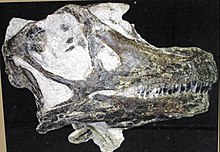Abydosaurus
| Abydosaurus | |
|---|---|

| |
| Holotype skull | |
| Scientific classification | |
| Domain: | Eukaryota |
| Kingdom: | Animalia |
| Phylum: | Chordata |
| Clade: | Dinosauria |
| Clade: | Saurischia |
| Clade: | †Sauropodomorpha |
| Clade: | †Sauropoda |
| Clade: | †Macronaria |
| Family: | †Brachiosauridae |
| Genus: | †Abydosaurus Chure et al., 2010 |
| Type species | |
| †Abydosaurus mcintoshi Chure et al., 2010
| |
Abydosaurus (meaning "
Discovery

Abydosaurus is one of the few sauropods known from skull material, with the first described complete skull for a Cretaceous sauropod from the Americas.[1] It is also notable for its narrow teeth, as earlier brachiosaurids had broader teeth.[1]
Abydosaurus is based on the
Abydosaurus was named in 2010 by Daniel Chure and colleagues. The genus name is a reference to
Description
Although Abydosaurus lived some 50 million years after Giraffatitan, the skulls of these two genera are similar except for the narrower, sharper teeth and smaller nose of Abydosaurus. Abydosaurus can be differentiated from all other sauropods, including Giraffatitan, by subtle features of the nasal and maxillary bones, its relatively small external nares (nostrils), and some features of the teeth.[1] In 2012 Thomas Holtz gave a length of 18.3 metres (60 ft).[4]
References
- ^ PMID 20179896.
- ^ Liu, P.X. (26 February 2010). "Recently Discovered Dinosaur Named After Retired Professor". The Wesleyan Argus. Wesleyan University. Archived from the original on 9 March 2010. Retrieved 1 March 2010.
- ^ "Wesleyan University Physics Department People". Wesleyan University. Archived from the original on 2010-01-26. Retrieved 1 March 2010.
- ^ Holtz, Thomas R. (2012). "Holtz's genus list" (PDF).
External links
- "Abydosaurus: New dinosaur discovered head first, for a change". BYU News. Feb 23, 2010. Archived from the original on 27 February 2010. Retrieved 8 October 2016.
